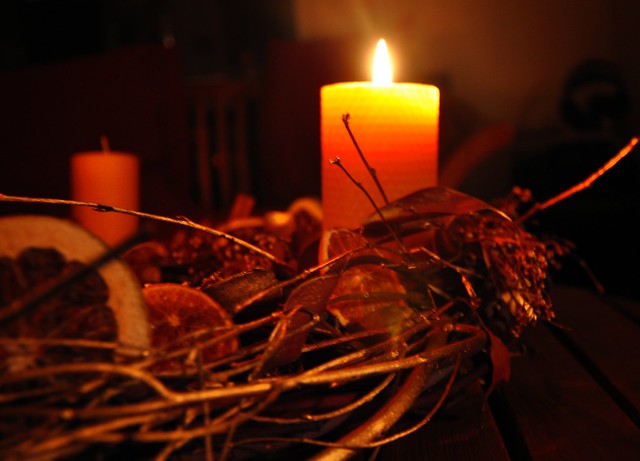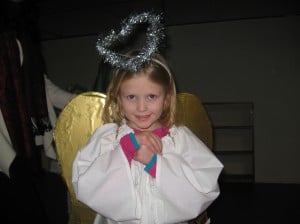Almost a week has passed since Advent began last Sunday, and I have yet to dig the Advent wreath out of its basement storage bin, yet to fit the candles into their sockets. I’ve been busy, yes…but also a little reluctant to embrace Advent this year.
I usually approach Advent eagerly, as a time of expectant waiting and to ready our home for the Christ child’s coming with steady hand and gleaming eye, not unlike how I prepared for each of my children’s births, stocking the freezer with heat-and-eat meals and filling dresser drawers with tiny clothes.

But I’m especially aware this year that preparing for a child’s arrival requires far more than serene nesting. Birth also brings hard work and pain, blood and sweat and shit. A child’s birth is not an ending but a beginning, and every life, no matter how boldly promised, no matter how welcomed, will be marked by agony and failure and grief along with love and grace and miracle. In the pleasant melancholy glow of candles lit against the December chill, it is easy to forget that the hope embodied by the Christ child will not be fully apparent until a Sunday morning more than three decades after his birth, and that before that Sunday morning, the baby in the straw will be misunderstood, mocked, driven out, beaten, and murdered.
And Advent waiting isn’t so hard when we know that what we’re waiting for will come—that Mary and Joseph will find a place to stay, that the baby will be born healthy, that December 25th will arrive with the scent of coffee and bacon drifting around delighted children, a warm fire in the grate and the promise of a bountiful meal later on.
This Advent, my serene nesting has been eclipsed by the hard work and pain, the blood and sweat and shit, the agony and failure and grief in this time of mass shootings, terrorist attacks, angry voters, presidential candidates who appeal to our most divisive instincts, extremism that pollutes the essential tenets of faith, environmental catastrophe, and our routine failure to do anything that might help, even when we know what needs to be done.
This Advent, so many are waiting for something not nearly as certain and solid and real as the squawl of a healthy new baby or Christmas morning greeted with a hot mug of coffee in hand. A friend waits to see if a job will come to allow her family to stay in the community where they have begun to grow roots, after the job that they expected to be secure fell victim to budget cuts. Everywhere people are waiting, to see if the latest scan shows that the tumor is shrinking, if the paycheck will allow for a few small holiday treats, if the old furnace will make it through another winter, if this time rehab will stick. We wait for the next mass shooting and the next terrorist attack. We wait to see if San Bernardino will do what Virginia Tech and Aurora and Sandy Hook couldn’t, if this shooting will finally—finally—force us to acknowledge our misguided approach to gun violence and the need for major change.
Waiting is hard. Waiting feels passive but in fact is tied up with action—the prayer and rituals that sustain us through the most agonizing days of waiting for something that lies outside our control, the hard work necessary to change minds and laws, behaviors and assumptions.
This weekend, I will make a wreath from the cuttings of our Christmas tree, and find the stubs of last year’s purple and pink candles. I will sit in a dark church at our Advent Lessons and Carols service, hearing again the story of God’s love for the world and my children’s retelling the same story in song. At supper, we will light two of the purple candles. I will enjoy the quiet loveliness of these rituals, as I always do.
But instead of simply appreciating how Advent rituals embody the hope embedded in the Christmas story, I will claim that hope for myself and the friends who have named the real and powerful hopelessness that laps at our heels in these days so full—so goddamn full— of private struggle and public heartbreak, of injustice and rage and violence.
Practicing Advent hope in the face of hopelessness is the fundamental—sometimes hardest—work God has given us to do. We are tempted to either rush through the disquieting ambivalence of Advent to get to clear-eyed Christmas joy, or dismiss it all as a foolish fairy tale belied by the world’s harsh realities.
To claim and to live Advent hope in a world so wounded is to understand that hope is not quite as simple and pleasant as a flickering candle warming a Sunday supper table. Advent hope comes bundled with worry and work, it catches the light through a layer of grit and grime. Advent hope is our companion on a journey marked by pain and joy, weariness and optimism, love and loneliness, death and resurrection—a journey that won’t end until the kingdom that stirred to life when a baby took his first breath in a barn 2,000 years ago comes for good.











